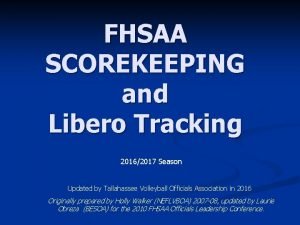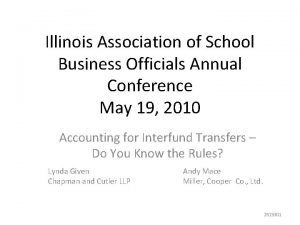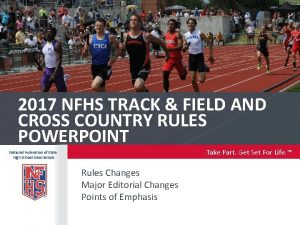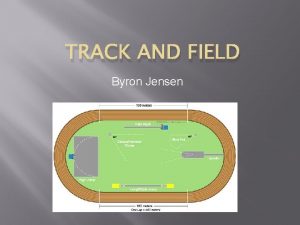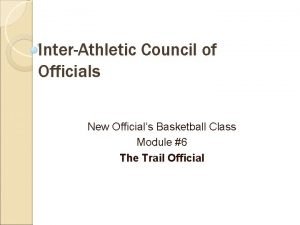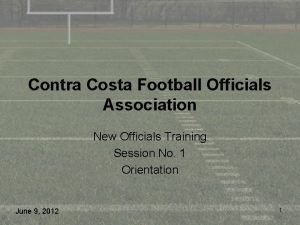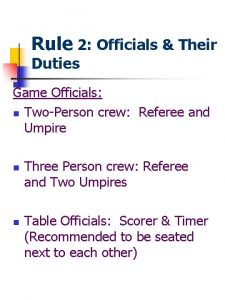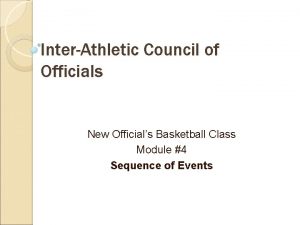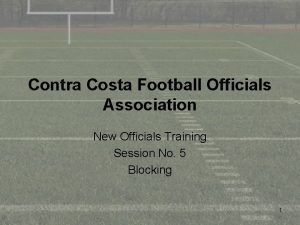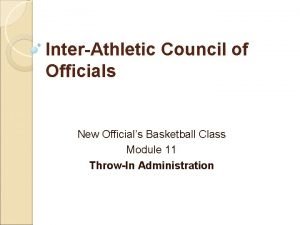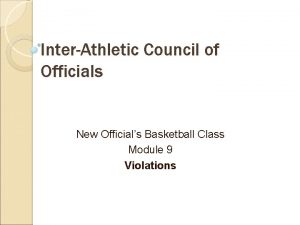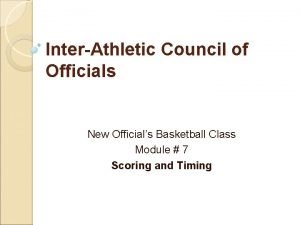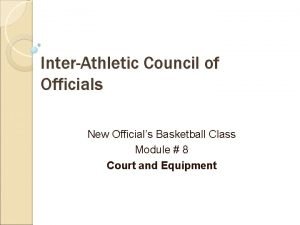Florida High School Track Officials Track Field Umpiring
































- Slides: 32

Florida High School Track Officials Track & Field Umpiring 1

UMPIRES • “The Eyes and Ears of the Referee” Observe & report. • Umpires DO NOT Disqualify Athletes; they report what they see to the Referee who will then make the decision. • If you see an infraction, raise the yellow flag and stay at your position until the Referee (or Head Umpire) comes to you. • Be prepared to give a Full (written) Description of who did what to whom and when. • If you’re not sure, don’t make the call. • If you see a situation you know is not a foul, but there may be a question, write a report to pass it on to the Referee or Head Umpire. 2

UMPIRES • Use the proper rules to a situation. If in doubt check the rule book • Report observations • Use consistent and clear communications • Positive proactive approach (including preventive officiating) • Know your area of responsibility on the track • Will watch multiple runners at one time 3

Umpire Equipment • Proper Uniform • Flags (White, Yellow, Red, Green) • NFHS Rule Book • Pens or Pencils • Clipboard/Incident Cards 4

UMPIRES Umpires Assembly and Umpire Positions • Be Punctual • Be at your assigned track position – 10 minutes before the event starts • Stand when runners are in your area of responsibility. • You should sit until the announcer calls the event or when you know the race is about to start. • After the last heat you should move to your next assignment as quickly as possible. 5

Umpire Flags The Umpires Communication Device Yellow Flag. . . All Umpires White Flag. . . Zone Chief, Umpire at Start, Umpire at Finish or Break (Line or Point) Red Flag. . . Umpire at Start & Umpire at Finish Green Flag. . . Umpire at start 6

Flag Etiquette REFEREE DETERMINES FLAG USE If you do signal with a flag, do not wave the flag, just hold it straight up above your head. If you see a violation, raise the Yellow flag and hold up until observed by Head Umpire or Referee. If a close situation occurs in front of you, but is not a violation, hold up the White flag for a period of time to signal that you witnessed the situation and determined that it was not a violation. Relay Zone Checks: Hold up Yellow flag until zone is ready then switch to White flag. Hold these flags up until announcer recognizes your zone or starter acknowledges. Relay Zone Flagging: Each zone will have multiple umpires, the Zone Chief will designate one of the umpires to signal a clean exchange or zone violation. Only one umpire should signal the zone result. 7

Possible Incidents - Running Incidents • Aiding or assisting teammate • Interference of a competitor * Bumping * Tripping * Veering • Running on or over inside lane line on a curve • Running in adjacent lane and interferes • Running outside lane and interferes • Does not start or finish in assigned lane • Break line violation • Deliberately running on or inside curb to gain advantage or position 8

- When a race is run in lanes, competitors are expected to run the entire race in their assigned lanes. A competitor shall be considered to be out of the lane when: - Without being fouled and while running around a curve, steps on or over the inside line or curb for three or more consecutive steps with either or both feet. - Takes one or more steps inside the assigned lane line at the break line. 9

Cone Placement USATF Rule 160. 8(c): “. . Small markers, such as cones or prisms 5 cm x 5 cm and no more than 15 cm high, shall be placed on the lane lines immediately before the intersection of the lane lines and the break line. 1 2 3 4 5 6 7 8 10

Observe & Report Possible Violations Running • Running on or over inside lane line on a curve 11

Infractions for Races not Run in Lanes In a race involving a curve where lanes are not specified, a competitor may move toward the inside or outside of the track provided he/she is one full running stride, approximately 7 feet, in advance of the competitor whose path is crossed. It is not a foul if a competitor crosses to the inside or outside if this action does not interfere in any way with another competitor. 12

NOTE: What Constitutes a Lane Violation? • NFHS – While running around a curve takes Three or more consecutive steps on or over the inside lane line or curb with either or both feet. (left, right, or a combination of both) • NCAA USATF Races run in lanes Running on the outside of a lane line on a curve is NOT a foul, as long as the runner does not interfere with the runner assigned to that lane. Running outside a lane on a straight is NOT a foul as long as there is no interference and no advantage is gained. 13

HURDLES • Hurdle Placement: aligning edge of crossbar closest to approaching athlete directly above edge of mark on track closest to approaching athlete. • Set hurdles from start line to finish line. • Check hurdle position, heights, position of weights (as hurdle height is raised, weights move back from the base). 14

HURDLE SETUP ON THE TRACK Align the Hurdle top crossbar exactly over the mark on the track. 15

Observe & Report Possible Hurdle Violations • Hurdle Incidents • Does not attempt to clear hurdle • Knocks down hurdle with hand • Hooking hurdles • Runs over hurdle in adjacent lane • Running around hurdles • Interferes with another hurdler 16

Hurdle Technique Violations • Observe and report if competitor fails to clear the horizontal plane of a hurdle crossbar. Two elements: Outside and Below the crossbar 17

RELAYS Relays are races between teams of four competitors, each running only one leg. An individual leg of the race is finished when the incoming competitor passes the baton to the outgoing competitor and steps off of the track when clear. 18

Possible Incidents - Relays Relay Incidents • A team members runs more than one leg of a relay • Gloves not permitted • Transporting baton in other than the hand • Last runner finishes the race without the baton • Baton passed outside 20/30 meter exchange zone • Baton recovered illegally after being dropped • Veering out of exchange zone & interferes with adjacent lane • Runner starting outside exchange zone 19

Relays - General Information - Each competitor shall carry his/her own team’s baton by hand. . . pass it to the succeeding teammate. The first competitor shall start with the baton, and the last competitor shall carry the baton until he/she has finished the race. A baton that inadvertently leaves a runner's hand must be retrieved immediately without interference to other runners. Note: In the 4 x 100 meter and 4 x 200 meter relay, and other relays with legs of 200 meters or less, each exchange zone will be 30 meters long. All exchange zones for races more than 200 meters will remain at 20 meters. - If the baton is dropped in the exchange zone, IN A LEGITIMATE ATTEMPT TO HAND IT, either competitor may retrieve it, even from another lane or off the track, provided the competitor does not interfere with an opponent and no advantage is gained. If the baton is dropped outside the exchange zone, it must be retrieved by the competitor who dropped it. - In relay races, each outgoing competitor, while waiting for the baton, shall take a position entirely within the exchange zone and must complete the exchange while the baton is within the exchange zone. - After passing the baton, the relieved competitor should stand still or jog straight ahead and step off the track when clear. 20

Relay Initial positions of outgoing Runners • Initial positions for runners 4 x 100 & 4 x 200 exchange zones • Initial positions for runners 4 x 400 & 4 x 800 exchange zones Legal Illegal Legal 21

Relay Passes Baton Must Be Within the Zone Beginning of Zone 22 ILLEGAL

Relay Handoffs - Inbound Legal 23

Relay Handoffs - Outbound Legal 24

Observe & Report Possible Relay -Violations • 25 Veering out of passing zone & interferes with adjacent lane.

Observe & Report Possible Relay Violations • Break line violations. 800 M-1600 M and 3200 M Note: In the 4 x 800 the first runner must stay in their lane to the break line. In the 4 x 400, the lead-off runner must stay in the assigned lane. The 2 nd leg runner must stay in assigned lane until the break line. 26

Umpire Incident Card Front 27

Umpire Incident Card Back 28

Some general rules to remember when Umpiring Follow the umpire's motto: Triple A: Be Awake, Be Aware, Be Alert. "ONLY THE REFEREE CAN DISQUALIFY AN ATHLETE" • Your job is to report the infraction. • The umpire's job begins the moment the race starts and ends when the finish line results are complete. • Make sure your post is attended at all times. • Carry a note pad and pencil/pen to record information and make notes. • Raise a yellow flag to signal "infractions" the moment they occur. • if you think it happened. . . it didn't. If you know it happened. . . it did. • Be able to describe to the Head Umpire and/or Referee what happened. • Record the bib number of the competitor who committed the infraction, the color of jersey, the number of the lane and the bib number of the competitor violated. • Wait until after verbally reporting any infraction to the Head Umpire and/or Referee before discussing it with other Umpires. 29

Some general rules Continued • Be firm, but respectful, in dealing with athletes such as instructions for relays etc. Do this also with coaches (IF Referee requests that you talk to them). • Refer a coach, athlete or spectator, to the Referee if they have a question about an infraction. • Make sure only approved markings are allowed on the track. • Straighten the hurdles after the last warm-up & help pick up hurdles that are knocked down during heats. • Verify correct positioning of the hurdles, the height and weights after the hurdle crew sets them up. • Take a crouched position to observe the hurdle events. • Most relay fouls occur as the runners exit the exchange zone. • Know the intent of the rules under which the competition is being held and be alert at all times. • Practice preventive officiating, be visible and vocal. 30

Some general rules Continued • Apply rules fairly and equally to everyone. • Tell athletes what the exchange zone markings are. • Remove tape, markers, tennis balls, etc. from vicinity of exchange zone after each race. • Do not physically place relay runners or tell them where to stand. • Do not argue with athletes, coaches or parents. • Do not tell an athlete that they have been disqualified. • Do not pull an athlete from their event. 31

Florida High School Track Officials Track & Field Umpiring Questions 32
 4x100 relay exchange zone markings
4x100 relay exchange zone markings Cricket umpiring signals
Cricket umpiring signals Middleton high school track and field
Middleton high school track and field Mid florida officials association
Mid florida officials association Holland middle school track and field
Holland middle school track and field Florida high school athletic association basketball
Florida high school athletic association basketball Fhsaa volleyball score sheet pdf
Fhsaa volleyball score sheet pdf Montana association of school business officials
Montana association of school business officials Colorado asbo
Colorado asbo Resolution no. 435 series of 1997
Resolution no. 435 series of 1997 Pennsylvania association of school business officials
Pennsylvania association of school business officials Illinois association of school business officials
Illinois association of school business officials Oregon association of school business officials
Oregon association of school business officials Mississippi association of school business officials
Mississippi association of school business officials Pioneer highschool map
Pioneer highschool map Field hockey markings
Field hockey markings Officiating track and field
Officiating track and field Inglemoor track and field
Inglemoor track and field Barton hundley
Barton hundley Nfhs track and field dimensions
Nfhs track and field dimensions Marc mangiacotti
Marc mangiacotti Nfhs track and field rule book
Nfhs track and field rule book Clishina
Clishina Rules of high jump
Rules of high jump Common track and field injuries
Common track and field injuries Crescenta valley high school summer school
Crescenta valley high school summer school Assignment in spanish
Assignment in spanish Electric field and magnetic field difference
Electric field and magnetic field difference Individual differences factors
Individual differences factors Field dependent vs field independent
Field dependent vs field independent Electric field and magnetic field difference
Electric field and magnetic field difference E field h field
E field h field Data types and field properties
Data types and field properties






